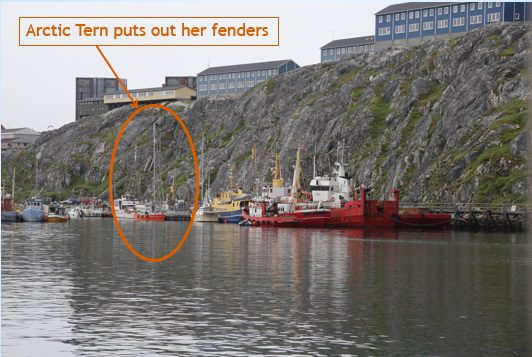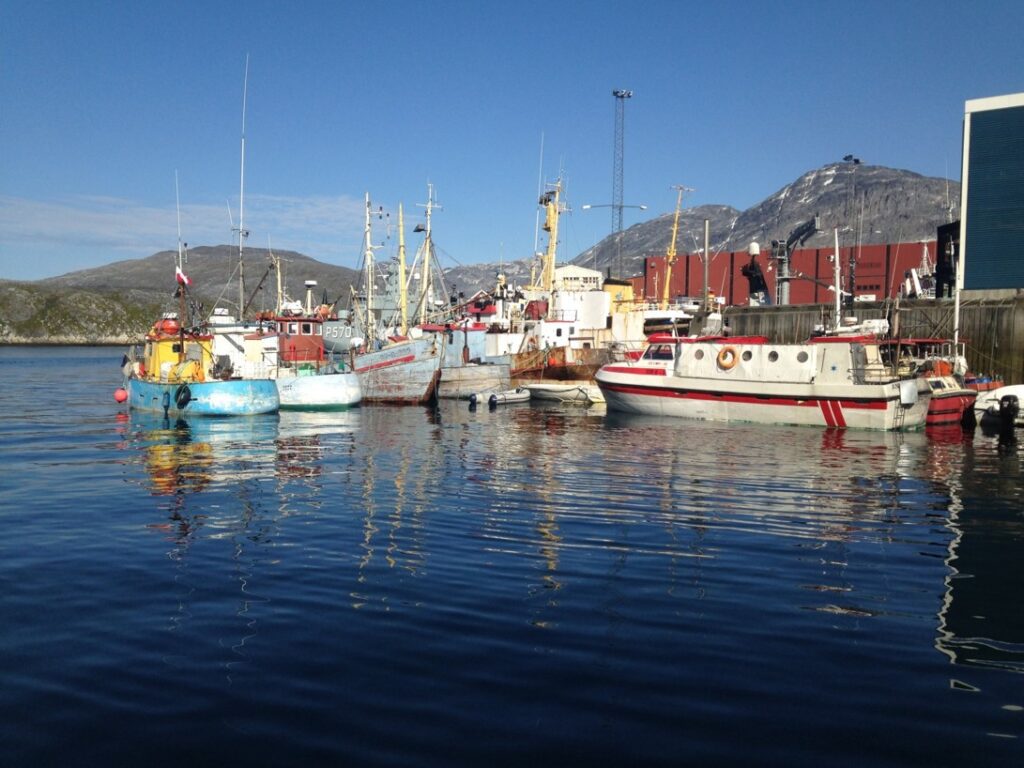Nuuk
Back entry from July 16th (64o 10’N, 51o 44’W): Nuuk
After our sobering encounter with ice off the southwest coast of Greenland on the evening of the 14th, we motored in thick fog up the coast towards Nuuk, never seeing a hint of land the entire 200 miles. Chris voiced his skepticism that it even existed. None-the-less, placing our faith in the chart plotter and GPS, we found our way to an approach point for Nuuk harbor and proceeded inbound, connecting the electronic dots, as we motored from one waypoint to the next. As with our approach to St. Mary’s Labrador, the fog began to lift as we approached land, revealing the beauty of the tens, if not hundreds, of small islands lining the 10 mile passage inward.
By the last mile or two, we were motoring in good visibility under a low ceiling of fog, revealing the industrial looking harbor of Nuuk. Along the shoreline and the hills behind were stark looking warehouses and apartment buildings. On a bluff in the middle of the facing shore stood a row of homes that looked as if they could be vacation cottages. In contrast, every other structure in view had a utilitarian tone. Proceeding further, we rounded a point dominated by large petroleum storage tanks and then motored past a large grey Danish naval vessel secured to the wharf. Above the wharf was a yard stacked with intermodal shipping containers.
Looking for signs of sailboat masts, we continued left around the end of the wharf, revealing the inner harbor, consisting of two side-by side bays, each roughly the shape and size of a football field, looking end on. The two bays were separated by a jetty with a warehouse on top. Their sides were vertical, to accommodate the 13 foot tides. The one on the left was occupied by official looking vessels, and was obviously not an option. The one on the right was filled with an impressive assortment of ships, from salty looking 50 foot commercial boats, made of wood and steel, to rows of small skiffs at the far end. The larger boats were tied 4 to 5 boats deep along the sides of the bay. Included in this mix were a handful of cruising sailboats, looking as if they might be headed to the Northwest Passage.
Calls to the harbor master on the VHF went unanswered, but one of the sailboats halfway down the inner harbor was putting out fenders in an open invitation to join alongside. We motored to the far end of the bay as the crew prepared for a portside tie up and, after turning back around, joined up with the vessel Arctic Tern who was herself tied up on the outside of three commercial vessels, only the first of which was secured to the pier. The owners of Arctic Tern are Ali and Les, with crew member Randall having just joined them from California. After thanking them for allowing us to tie up, we followed with the typical first question of how to check in.

By international convention, yacht arriving form a foreign country fly a yellow quarantine flag from the starboard halyard. Upon arrival, only the captain is permitted to go ashore to clear emigration and customs. Until documents are reviewed and entry has been approved, the crew is not allowed to leave the ship. Les’s response was something to the effect that, “they don’t pay much attention to formalities here in Nuuk.” He said that the immigration officer had been unable to find the correct stamp for entering yachts, but was going to look for it and might be down later in the afternoon. With that implicit approval for the crew to go ashore, we asked the next barrage of questions. Where could you get a shower, do laundry, grocery shop, get cash, buy fuel, find water, etc.? Coming from Wales, this is Les’s eighth time in Nuuk. He and Ali knew the answers to our questions and were as generous in sharing their knowledge as they had been in offering us a place to land.

During our short stay in Nuuk, Arctic Tern would guide us through the logistics of resupply, including arranging and literally leading us to fuel and water. The later involves negotiating with the local officials and tying up to the search and rescue vessel in the first bay to receive water through a fire hose … something not obvious to the first time visitor. Arctic Tern is planning to attempt the Northwest Passage this year, having turned back last year in consideration of the higher volume of ice in 2013. Before leaving Nuuk, we exchanged contact information and they provided us with a wealth of information on harbors along the coast of Greenland. If it weren’t for Arctic Tern and crew, I would still be trying to contact the harbor master to find a place to tie up.